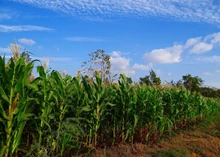
Rye (Secale cereale) is a versatile grass cultivated widely for its grain, as a cover crop and for forage. Belonging to the wheat tribe (Triticeae), it shares close botanical relationships with wheat and barley (genera Triticum and Hordeum). The top producers of rye globally include Russia, Germany, Austria, Hungary, USA, Canada, Poland, and Turkey. In India, rye cultivation is primarily found in Punjab, Haryana, and Uttar Pradesh. Notably, rye is a cereal grain. It is distinct from ryegrass (Lolium), which is primarily utilized for lawns, pasture, and as hay for livestock.
Sowing Time
-
For forage purposes, October is the optimal time for rye cultivation.
-
If grown as a grain crop, November is the best month for sowing.
-
However, for pasture, green manure, or cover crops, rye should be sown in August.
Climate and Soil
-
Rye is a winter cereal, resilient to cold weather but sensitive to heat.
-
It thrives in sandy soil, making it the preferred Rabi cereal, but it can also be cultivated in various soil types. It is typically grown during both winter and spring seasons.
Seed Rate
Rye is typically sown at a rate of 80 kg per hectare, while for grain production, the seeding rate is generally 60 kg per hectare.
Planting Method
-
Similar to other winter cereals, rye is typically shown using drill seeding, which is preferred over broadcasting for better results. In terms of nutrient management, several recommendations are suggested.
-
Before sowing, it's advisable to incorporate approximately 12.5 tonnes per hectare of Farm Yard Manure (FYM). For nitrogen application, a rate of 50 kg per hectare is recommended, to be split into two applications: as basal fertilizer and during the first irrigation.
-
Phosphorus should be applied at a rate of 40 kg per hectare as basal fertilizer, while potassium should be applied at a rate of 65 kg per hectare, also as basal fertilizer. These practices help ensure optimal growth and yield of rye crops.
Irrigation
-
The Critical Rooting (CRI) and flowering stages are crucial for irrigation management in rye cultivation.
-
Optimal yields are achieved with six irrigations: during sowing, CRI (20-25 days after sowing), tillering (40-45 DAS), late jointing (70-75 DAS), flowering, and dough stages.
-
In cases of limited water availability, prioritize irrigation at CRI; for better results, include CRI and flowering stages; and for optimal yield, ensure irrigation at CRI, late jointing, and flowering stages.
Crop Protection
-
Rye cultivation faces various challenges from pests and diseases like Bacterial blight, caused by Xanthomonas translucens, leads to water-soaked spots on foliage and stunted plant growth.
-
Barley yellow dwarf virus (BYDV) causes stunted growth and yellowing of leaves, transmitted by aphids.
-
Loose smut, caused by Ustilago tritici, results in dark green or black masses in place of kernels.
-
Net blotch, powdery mildew, and rust are fungal diseases causing leaf discoloration and lesions.
-
Additionally, pests like aphids, armyworms, and wireworms pose threats, causing leaf damage and reduced yields.
-
Integrated pest and disease management strategies, including seed treatments, crop rotation, and insecticide application, are crucial for mitigating these risks in rye cultivation.
Harvesting
-
For forage purposes, rye is typically harvested through two cuttings at intervals of 50-55 days. Similarly, for forage cum grain production, two cuts are made with the second cut occurring after maturity.
-
Yields vary depending on the purpose: for fodder alone, yields can reach 50-55 tonnes per hectare, while for dual cropping, yields may comprise 25 tonnes per hectare of fodder, along with 2.5 tonnes per hectare of grain and 2.5 tonnes per hectare of straw.
Varieties
-
Unlike wheat, barley, or oats, rye does not boast numerous varieties. However, specific varieties are cultivated based on the season and intended use.
-
For winter cultivation, notable forage types include Athens, Common, and Abruzzes, whole grain-focused varieties include Rosan, Dakold, and Balba.
-
In the spring season, varieties like Prolific and Merced are commonly grown.
-
These varieties require different agricultural needs and environmental conditions, providing options for both forage and grain production.
Uses
-
Rye is chiefly used for rye bread and whiskey.
-
It's rich in carbs, fiber, and provides some protein, potassium, and B vitamins.
-
Besides human consumption, it's used for livestock feed, pasture, and soil improvement.
-
Although it contains gluten, it's less elastic than wheat for bread-making.










